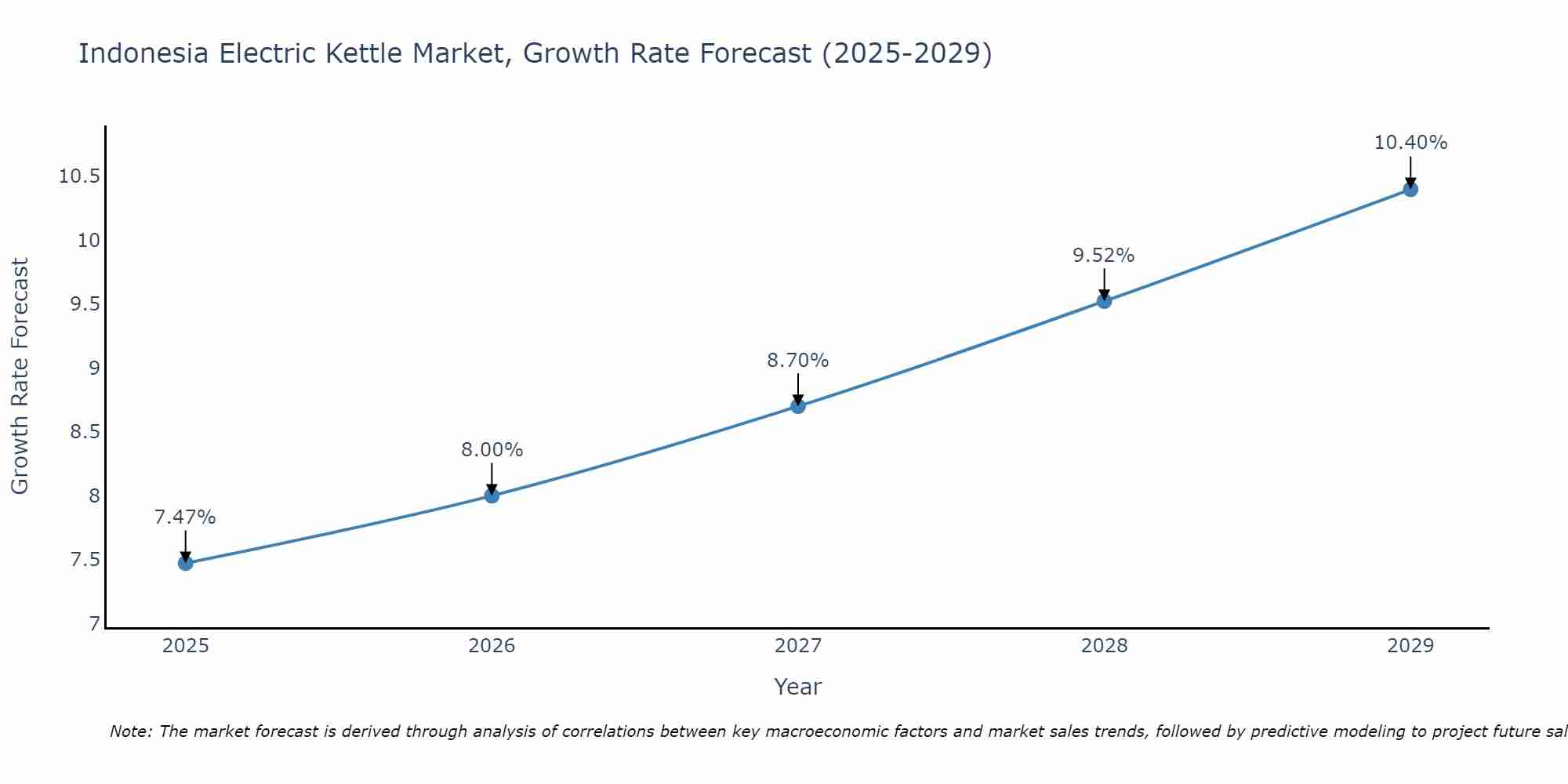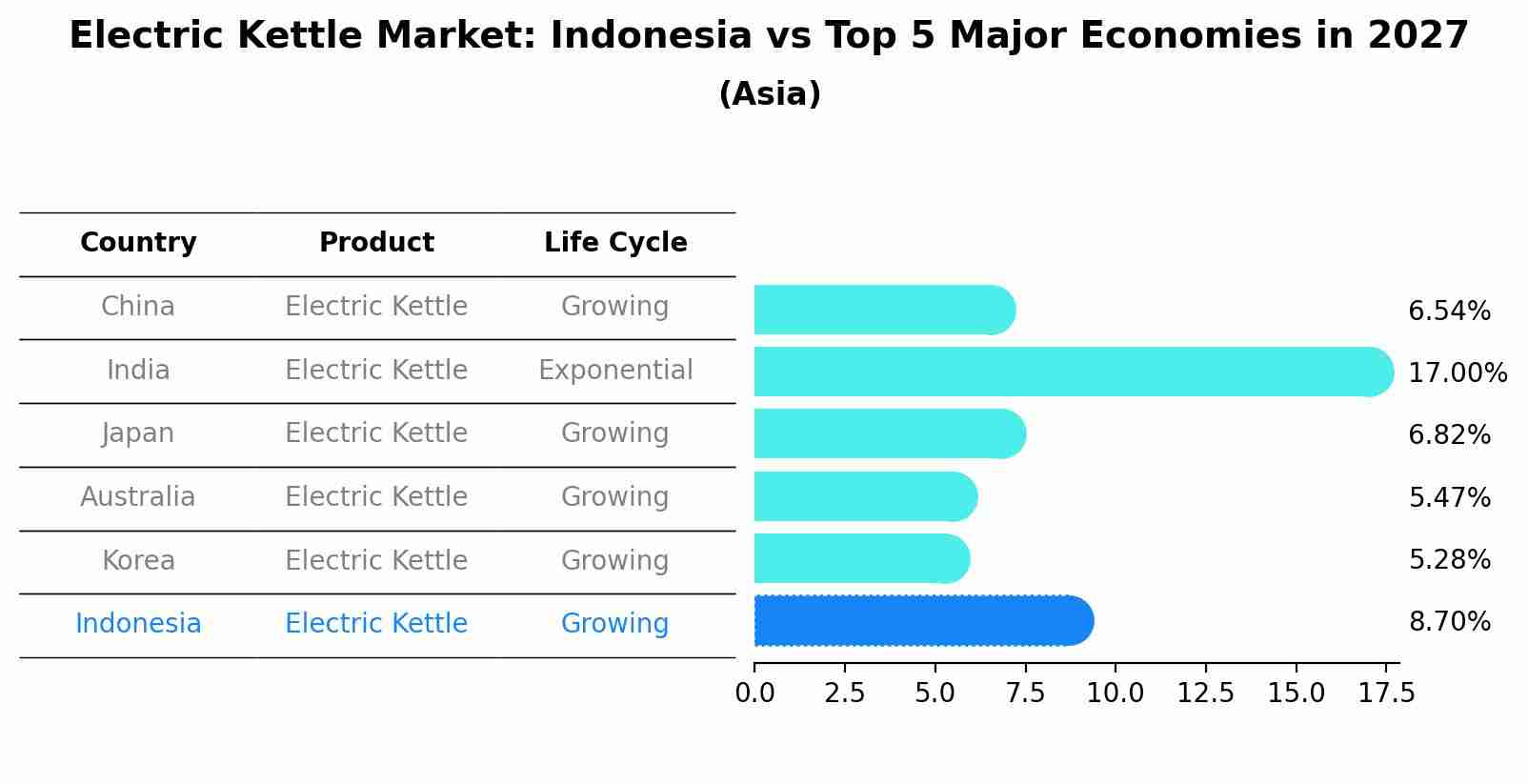Indonesia Electric Kettle Market (2025-2031) Outlook | Value, Analysis, Growth, Size, Revenue, Trends, Industry, Forecast, Share & Companies
| Product Code: ETC107807 | Publication Date: Jul 2023 | Updated Date: Apr 2025 | Product Type: Report | |
| Publisher: 6Wresearch | No. of Pages: 70 | No. of Figures: 35 | No. of Tables: 5 | |
Indonesia Electric Kettle Market Size Growth Rate
The Indonesia Electric Kettle Market is likely to experience consistent growth rate gains over the period 2025 to 2029. Commencing at 7.47% in 2025, growth builds up to 10.40% by 2029.

Electric Kettle Market: Indonesia vs Top 5 Major Economies in 2027 (Asia)
In the Asia region, the Electric Kettle market in Indonesia is projected to expand at a growing growth rate of 8.70% by 2027. The largest economy is China, followed by India, Japan, Australia and South Korea.

Indonesia Electric Kettle MarketSynopsis
Electric Kettle is a device that is used to heat water or other liquids. It has become an essential kitchen appliance for many households in Indonesia over the past few years. The demand for electric kettles has been growing steadily due to its convenience and safety features, as well as the increasing availability of modern designs with different functionalities such as temperature control, auto shut-off, etc.
Market Trends
The Indonesia electric kettle market is driven by rising disposable income levels, changing lifestyle preferences and consumer inclination towards energy efficient products. Increasing awareness about health benefits of consuming boiled water is also contributing to the growth of this industry. Furthermore, technological advancements such as cordless kettles with LED display are expected to drive further innovations in design and functionality leading to increased sales over the forecast period.
Market Drivers
The major drivers behind the growth of Indonesia electric kettle market include increasing urbanization coupled with rapid economic development which have resulted in higher purchasing power among consumers; growing preference for automated home appliances; improving lifestyles; and increasing popularity of various online shopping platforms making it easier to buy electrical appliances at affordable prices. In addition, manufacturers are continuously innovating their product portfolio according to customer needs resulting in wider range available for customers at competitive prices which drives up demand among price sensitive buyers.
COVID-19 Impact on the Market
The impact of COVID-19 pandemic on Indonesia Electric Kettle Market was initially negative owing largely due government imposed restrictions on movement coupled with job losses resulting from economic shutdowns thereby reducing discretionary spending capacity amongst people across all classes. However, post lifting these restrictions there is a surge in demand seen not only in e-commerce but also retail outlets thus driving short term revival trend within this sector although full industry recovery may take longer time depending upon prevailing economic situation.
Challenges of the Market
Despite being one of Southeast Asia?s fastest growing markets , Indonesia Electric Kettle market faces certain challenges like difficulty faced by local producers to compete with imported products because they lack capital investment needed for innovation & production efficiency ; furthermore lack or inadequate supply chain infrastructure leads too high transportation cost & pricing pressures ultimately impacting profitability margins. In addition , lower brand loyalty amongst buyers makes marketing efforts challenging & requires greater promotional costs thus adversely affecting profits again.
Industry Key Players
Some key players operating within Indonesia Electric Kettle Market include Philips , Panasonic Japan , Midea China , Haier China.
Key Highlights of the Report:
- Indonesia Electric Kettle Market Outlook
- Market Size of Indonesia Electric Kettle Market, 2024
- Forecast of Indonesia Electric Kettle Market, 2031
- Historical Data and Forecast of Indonesia Electric Kettle Revenues & Volume for the Period 2021-2031
- Indonesia Electric Kettle Market Trend Evolution
- Indonesia Electric Kettle Market Drivers and Challenges
- Indonesia Electric Kettle Price Trends
- Indonesia Electric Kettle Porter's Five Forces
- Indonesia Electric Kettle Industry Life Cycle
- Historical Data and Forecast of Indonesia Electric Kettle Market Revenues & Volume By Raw Material for the Period 2021-2031
- Historical Data and Forecast of Indonesia Electric Kettle Market Revenues & Volume By Stainless Steel for the Period 2021-2031
- Historical Data and Forecast of Indonesia Electric Kettle Market Revenues & Volume By Plastic for the Period 2021-2031
- Historical Data and Forecast of Indonesia Electric Kettle Market Revenues & Volume By Glass for the Period 2021-2031
- Historical Data and Forecast of Indonesia Electric Kettle Market Revenues & Volume By Others for the Period 2021-2031
- Historical Data and Forecast of Indonesia Electric Kettle Market Revenues & Volume By Application for the Period 2021-2031
- Historical Data and Forecast of Indonesia Electric Kettle Market Revenues & Volume By Residential for the Period 2021-2031
- Historical Data and Forecast of Indonesia Electric Kettle Market Revenues & Volume By Commercial for the Period 2021-2031
- Indonesia Electric Kettle Import Export Trade Statistics
- Market Opportunity Assessment By Raw Material
- Market Opportunity Assessment By Application
- Indonesia Electric Kettle Top Companies Market Share
- Indonesia Electric Kettle Competitive Benchmarking By Technical and Operational Parameters
- Indonesia Electric Kettle Company Profiles
- Indonesia Electric Kettle Key Strategic Recommendations
Frequently Asked Questions About the Market Study (FAQs):
1 Executive Summary |
2 Introduction |
2.1 Key Highlights of the Report |
2.2 Report Description |
2.3 Market Scope & Segmentation |
2.4 Research Methodology |
2.5 Assumptions |
3 Indonesia Electric Kettle Market Overview |
3.1 Indonesia Country Macro Economic Indicators |
3.2 Indonesia Electric Kettle Market Revenues & Volume, 2021 & 2031F |
3.3 Indonesia Electric Kettle Market - Industry Life Cycle |
3.4 Indonesia Electric Kettle Market - Porter's Five Forces |
3.5 Indonesia Electric Kettle Market Revenues & Volume Share, By Raw Material, 2021 & 2031F |
3.6 Indonesia Electric Kettle Market Revenues & Volume Share, By Application, 2021 & 2031F |
4 Indonesia Electric Kettle Market Dynamics |
4.1 Impact Analysis |
4.2 Market Drivers |
4.3 Market Restraints |
5 Indonesia Electric Kettle Market Trends |
6 Indonesia Electric Kettle Market, By Types |
6.1 Indonesia Electric Kettle Market, By Raw Material |
6.1.1 Overview and Analysis |
6.1.2 Indonesia Electric Kettle Market Revenues & Volume, By Raw Material, 2021-2031F |
6.1.3 Indonesia Electric Kettle Market Revenues & Volume, By Stainless Steel, 2021-2031F |
6.1.4 Indonesia Electric Kettle Market Revenues & Volume, By Plastic, 2021-2031F |
6.1.5 Indonesia Electric Kettle Market Revenues & Volume, By Glass, 2021-2031F |
6.1.6 Indonesia Electric Kettle Market Revenues & Volume, By Others, 2021-2031F |
6.2 Indonesia Electric Kettle Market, By Application |
6.2.1 Overview and Analysis |
6.2.2 Indonesia Electric Kettle Market Revenues & Volume, By Residential, 2021-2031F |
6.2.3 Indonesia Electric Kettle Market Revenues & Volume, By Commercial, 2021-2031F |
7 Indonesia Electric Kettle Market Import-Export Trade Statistics |
7.1 Indonesia Electric Kettle Market Export to Major Countries |
7.2 Indonesia Electric Kettle Market Imports from Major Countries |
8 Indonesia Electric Kettle Market Key Performance Indicators |
9 Indonesia Electric Kettle Market - Opportunity Assessment |
9.1 Indonesia Electric Kettle Market Opportunity Assessment, By Raw Material, 2021 & 2031F |
9.2 Indonesia Electric Kettle Market Opportunity Assessment, By Application, 2021 & 2031F |
10 Indonesia Electric Kettle Market - Competitive Landscape |
10.1 Indonesia Electric Kettle Market Revenue Share, By Companies, 2024 |
10.2 Indonesia Electric Kettle Market Competitive Benchmarking, By Operating and Technical Parameters |
11 Company Profiles |
12 Recommendations |
13 Disclaimer |
- Single User License$ 1,995
- Department License$ 2,400
- Site License$ 3,120
- Global License$ 3,795
Search
Related Reports
- Portugal Electronic Document Management Market (2025-2031) | Strategy, Consumer Insights, Analysis, Investment Trends, Opportunities, Growth, Size, Share, Industry, Revenue, Segments, Value, Segmentation, Supply, Forecast, Restraints, Outlook, Competition, Drivers, Trends, Demand, Pricing Analysis, Competitive, Strategic Insights, Companies, Challenges
- France Electronic Document Management Market (2025-2031) | Strategy, Consumer Insights, Analysis, Investment Trends, Opportunities, Growth, Size, Share, Industry, Revenue, Segments, Value, Segmentation, Supply, Forecast, Restraints, Outlook, Competition, Drivers, Trends, Demand, Pricing Analysis, Competitive, Strategic Insights, Companies, Challenges
- Portugal Occupational Health & Safety Services Market (2025-2031) | Strategy, Consumer Insights, Analysis, Investment Trends, Opportunities, Growth, Size, Share, Industry, Revenue, Segments, Value, Segmentation, Supply, Forecast, Restraints, Outlook, Competition, Drivers, Trends, Demand, Pricing Analysis, Competitive, Strategic Insights, Companies, Challenges
- Netherlands Occupational Health and Safety Services Market (2025-2031) | Strategy, Consumer Insights, Analysis, Investment Trends, Opportunities, Growth, Size, Share, Industry, Revenue, Segments, Value, Segmentation, Supply, Forecast, Restraints, Outlook, Competition, Drivers, Trends, Demand, Pricing Analysis, Competitive, Strategic Insights, Companies, Challenges
- Belgium and Luxembourg Facility Management Market (2025-2031) | Strategy, Consumer Insights, Analysis, Investment Trends, Opportunities, Growth, Size, Share, Industry, Revenue, Segments, Value, Segmentation, Supply, Forecast, Restraints, Outlook, Competition, Drivers, Trends, Demand, Pricing Analysis, Competitive, Strategic Insights, Companies, Challenges
- Russia Women Intimate Apparel Market (2025-2031) | Strategy, Consumer Insights, Analysis, Investment Trends, Opportunities, Growth, Size, Share, Industry, Revenue, Segments, Value, Segmentation, Supply, Forecast, Restraints, Outlook, Competition, Drivers, Trends, Demand, Pricing Analysis, Competitive, Strategic Insights, Companies, Challenges
- Africa Chocolate Market (2025-2031) | Size, Share, Trends, Growth, Revenue, Analysis, Forecast, industry & Outlook
- Global Hydroxychloroquine And Chloroquine Market (2025-2031) | Industry, Trends, Size, Outlook, Growth, Value, Companies, Revenue, Analysis, Share, Forecast
- Saudi Arabia Plant Maintenance Market (2025-2031) | Industry, Size, Growth, Revenue, Value, Companies, Forecast, Analysis, Share & Trends
- Taiwan Electric Truck Market (2025-2031) | Outlook, Industry, Revenue, Size, Forecast, Growth, Analysis, Share, Companies, Value & Trends
Industry Events and Analyst Meet
Our Clients
Whitepaper
- Middle East & Africa Commercial Security Market Click here to view more.
- Middle East & Africa Fire Safety Systems & Equipment Market Click here to view more.
- GCC Drone Market Click here to view more.
- Middle East Lighting Fixture Market Click here to view more.
- GCC Physical & Perimeter Security Market Click here to view more.
6WResearch In News
- Doha a strategic location for EV manufacturing hub: IPA Qatar
- Demand for luxury TVs surging in the GCC, says Samsung
- Empowering Growth: The Thriving Journey of Bangladesh’s Cable Industry
- Demand for luxury TVs surging in the GCC, says Samsung
- Video call with a traditional healer? Once unthinkable, it’s now common in South Africa
- Intelligent Buildings To Smooth GCC’s Path To Net Zero













